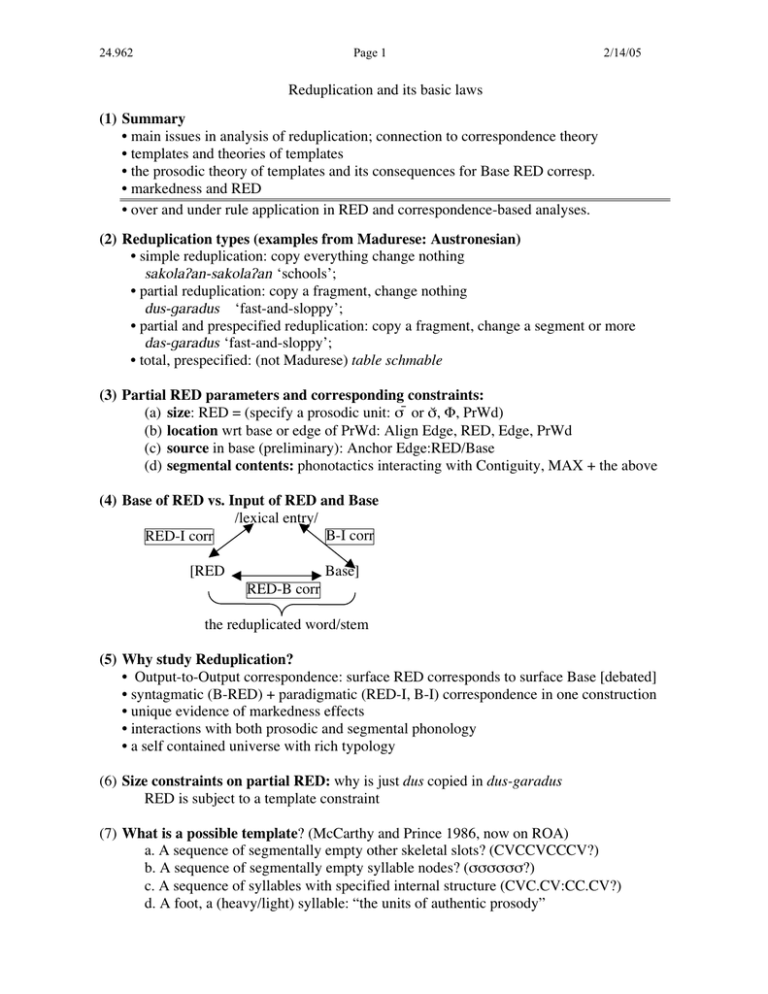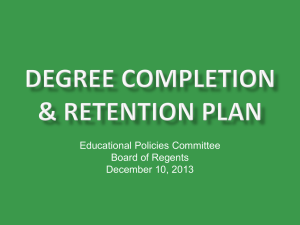Reduplication and its basic laws (1) Summary
advertisement

24.962 Page 1 2/14/05 Reduplication and its basic laws (1) Summary •main issues in analysis of reduplication; connection to correspondence theory •templates and theories of templates •the prosodic theory of templates and its consequences for Base RED corresp. •markedness and RED •over and under rule application in RED and correspondence-based analyses. (2) Reduplication types (examples from Madurese: Austronesian) •simple reduplication: copy everything change nothing sakola/an-sakola/an ‘schools’; •partial reduplication: copy a fragment, change nothing dus-garadus ‘fast-and-sloppy’; •partial and prespecified reduplication: copy a fragment, change a segment or more das-garadus ‘fast-and-sloppy’; •total, prespecified: (not Madurese) table schmable (3) Partial RED parameters and corresponding constraints: (a) size: RED = (specify a prosodic unit: s ¤ or s*, F, PrWd) (b) location wrt base or edge of PrWd: Align Edge, RED, Edge, PrWd (c) source in base (preliminary): Anchor Edge:RED/Base (d) segmental contents: phonotactics interacting with Contiguity, MAX + the above (4) Base of RED vs. Input of RED and Base /lexical entry/ B-I corr RED-I corr [RED Base] RED-B corr the reduplicated word/stem (5) Why study Reduplication? • Output-to-Output correspondence: surface RED corresponds to surface Base [debated] •syntagmatic (B-RED) + paradigmatic (RED-I, B-I) correspondence in one construction •unique evidence of markedness effects •interactions with both prosodic and segmental phonology •a self contained universe with rich typology (6) Size constraints on partial RED: why is just dus copied in dus-garadus RED is subject to a template constraint (7) What is a possible template? (McCarthy and Prince 1986, now on ROA) a. A sequence of segmentally empty other skeletal slots? (CVCCVCCCV?) b. A sequence of segmentally empty syllable nodes? (ssssss?) c. A sequence of syllables with specified internal structure (CVC.CV:CC.CV?) d. A foot, a (heavy/light) syllable: “the units of authentic prosody” 24.962 Page 2 2/14/05 (8) Reminder: Semitic stems (McCarthy 1979 MIT diss) [ <y >= IPA [j]) Form Past active katab-a kat:ab-a ka:tab-a /a-ktab-a ta-ka:tab-a n-katab-a ktatab-a sta-ktab-a 1 write 2 caus 3 recip 4 dictate 6 write letters to e.o. 7 sub-scribe 8 copy 9 ask s.o to Non-Past act ya-ktub-u ya-kat:ib-u yu-ka:tib-u yu-ktib-u ya-ka:tab-u ya-n-katib-u ya-ktatib-u ya-sta-ktib-u Past Pass kutib-a kut:ib-a ku:tib-a /u-ktib-a tu-ku:tib-a n-kutib-a ktutib-a stu-ktib-a Non-Past Pass yu-ktab-u yu-kat:ib-u yu-ka:tab-u yu-ktab-u yu-ta-ka:tab-u yu-n-katab-u yu-ktatab-u yu-sta-ktab-u Imperative ktubkat:ibka:tib/a-ktibta-ka:tabn-katibktatibsta-ktib- (9) Compare: Form Past active 1 study daras-a 2 caus dar:as-a (10) Morpheme shapes (not exhaustive) (a) Derivational morphemes (b) Non-derivational morphemes form 1: CVCVC (syncope in yV-kVtVb-u) Active: (u)-a-i1 form 2: CVCCVC Passive: u-a form 3: CV:CVC Non-Past yV-2 form 3: /a- CCVC form 6: ta-CV:CVC form 7: n-CVCVC (c) Invariant root shape: here ktb form 8: CtVCVC form 9: sta-CCVC --- CV slots: dominated by syllable nodes; dominate segments (11) Autosegmental assembly of morphemes: •L-R association of segments to template slots yields actual syllables. (in some cases the strict L-R order is replaced by other conventions) •Too many slots, not enough segments? E.g. sm ‘poison’: samam-, sam:am Spread the rightmost segment. •Too many segments, not enough slots? E.g. magnati:S ‘magnetize’ magnat. Delete the segments, add a coda position. •Critical assumption: features of each morpheme occupy distinct tiers from features of other morphemes. Affix u a i CV-CVVCV C Affix: Root: yields yu-ka:tib (form 3, non-past active) y k t b ========================================= 1 2 Vocalism is subject to further rules. Thus in the non-past active: u-a-i -> a-i in 7-9; u-a-i -> a in 5, 6. Past and non-past vowels are subject to dissimilatory conditions. Thus ya-ktub-u but katab-a 24.962 Page 3 Affix u a CV-CVVCVC Affix: Root: 2/14/05 yields yu-ka:tab (form 3, non-past passive) y k t b ========================================== •Biliterals work similarly but here the C’s must spread too: cf. sm ‘poison’ Affix u a i yields yu-sa:mim (form 3, non-past active)3 CV-CVVCVC Affix: Root: y sm ========================================== • LR association (+ OCP) explains why sa:mim and not *sa:sim •Quadriliterals have form 2 without gemination. (12) Templatic morphology without consonantal roots: Miwok (Smith 1984), English Basic Derived 2 Derived 5 Derived 6 Derived 7 Derived 8 polaat polat pollat polta poolat polaat kelti kelit kellit kelti keelit keliit halh halÈh hallÈh halhÈ haalÈh halÈÈh tapuu/ tappu tapu/ tappu/ tap/u taapu/ • [È] and [/] are epenthetic segments. • V and C on same tier, hence polat vs. polta difference requires reordering. • But same “LR” effect in mapping: running out of segments at R edge. (13) What is a possible template? (McCarthy and Prince 1986, now on ROA) a. A sequence of segmentally empty other skeletal slots? (CVCCVCCCV?) b. A sequence of segmentally empty syllable nodes? (ssssss?) c. A sequence of syllables with specified internal structure (CVC.CV:CC.CV?) d. A foot, a (heavy/light) syllable: “the units of authentic prosody” (14) Why (13. a) could not be right: English nicknames Base William Elizabeth Barbara Gabriel Herbert Diana Stuart Arthur Christine Agnes 3 An invented form. Truncated left Will, Liz, Barb, Gabe Herb Di Stu Art Chris Truncated and augmented Willie Lizzie Barbie (Gabi) Herbie Artie Chrissie, Christie Aggie Truncated right Beth Bert 24.962 Page 4 2/14/05 •template can’t be CVC: Herb, Stu •can’t be (C(C))V(C(C)): Gabe, *Gabrie; Aggie *Agnie •must be: 1 syllable (+ [i]), plus rules/principles on how to map the full word onto template. •Contiguity (nickname to base): segments in nickname are adjacent only if their full form correspondents are (Di, *Dine, *Dinie; Stu, *Stur, *Sturt; Will, *Wilm) •Ident stress (nickname to base): syllables in nickname are stressed iff their full form correspondents are (Liz, Beth, *El; Stu; *Art) •MAX (base to nickname): the largest number of segments from the base must be present in the nickname, (subject to the requirements of the template, Contiguity and MAX) Template: s + (i) Hérbèrt4 Herbert *! FHerb(ie) FBert(ie) *** *** Her Ber ****! ****! William FWill(ie) Wilm Agnes FAgg(ie) Ness(ie) Contiguity *! Ident Stress *! MAX MAX *** ** MAX *** ** (15) Why (13. b) could not be right: Vast majority of templates fall into a small number of options: 1 heavy syllable 1 light syllable 1 foot: an iamb (CVCV:, CVCVC) or a trochee (ss or s ¤ or s*s*) A small number of cases (Miwok, Semitic) display templates consisting of two syllables, whose weight and internal structure is specified. Virtually no templates consisting of sequences of syllables longer than 2. (16) Original template theory to original RED theory: Marantz 1982 •RED template = sequence of C, V slots, a McCarthy style 1979 Semitic template. •copy base segments, base tones (= ‘melody’). •association follows from the direction of affixation (LR-for prefixes; RL suffixes) • association is segment driven (gives priority to segment association rather than filling template slots) and subject to crossing line condition. •results wrt the correspondence relation between base and RED: 4 Effect of stress on preservation more clearly seen in Elizabeth -> Beth, Liz, *El, *Zab 24.962 Page 5 2/14/05 (a) RED doesn’t copy base syllables: rather, RED is a syllable (sequence) defined on the string of segments of the base, independently of how base is syllabified. (b) Locality: RED is (typically) adjacent to its source in the base. (c) Contiguity: CVC-nait yields na(:)-nait and not nat-nait . (d) MAX: empty slots must be filled. This causes the maximal number of segments and tones to be copied subject to slot availability, existing phonotactics, and the crossing line constraint. (17) What changed: •theory of templates: CVC is not a possible template, only s ¤ or s** is. 8 if no CVC slots then nothing to link copied segments to: some other mechanism must be adopted to “fill the template” with base segments. •discovery of Base-RED identity effects that go beyond copying of the melody. •discovery of markedness effects in RED that were unanticipated by early work. (18) Reduplication in Ilocano a. Nouns kaldi!N kal-kaldi!N pu!sa pus-pu!sa kla!se klas-kla!se ro!.ot ro…-ro!.ot b. Verbs basa bas-basa adal ad-adal trabaho trab-trabaho takder tak-takder ‘be reading’ ‘be studying’ ‘be working’ ‘be standing’ The Ilocano analysis: •Template for the reduplicating affix? •Location of affix? Source in the base? •Why kal-kaldi!N, *kald-kaldi!N ? ro…-ro!.ot •Why ro!.ot basa bas-basa not *rot-ro!.ot not *ba:-basa (19) 'goats' 'cats' 'classes' 'litter-pl' (16) Mokilese reduplication (Levin 1983): a. CVC… stems pOdok pOd-pOdok ‘plant’ mwiNe mwiN-mwiNe ‘eat’ kasO kas-kasO ‘throw’ poki pok-poki ‘beat’ b. CV stems pa pa…-pa di.ar di:-diar ‘weave’ ‘find’ c. CV:… stems sO…rOk sO…-sO…rOk tSa…k tSa…-tSa…k ‘tear’ ‘bend’ 24.962 Page 6 2/14/05 (17) Sanskrit desiderative reduplication (similar to perfect reduplication: Steriade 1988): Root pa: tvar pr`cÓ ji:v skand mu:r dÓma: bÓaj vid kßubÓ çay man stan pÓal syu syand smay sup sru spÓurj Reduplicated form pipa:-s-a:mi titvar-iß-a:mi pipr`cÓ-iß-a:mi jiji:v-iß-a:mi kiskand-iß-a:mi mumu:r-ß-a:mi didÓma:-s-a:mi bibÓaj-iß-a:mi vivid-iß-a:mi kukßubÓ-iß-a:mi çiçay-iß-a:mi miman-iß-a:mi tistan-iß-a:mi pipÓal-iß-a:mi susyu-ß-a:mi sisyand-iß-a:mi sismay-iß-a:mi susup-s-a:mi susru:-ß-a:mi puspÓurj-iß-a:mi Gloss 'drink' 'hasten' 'fashion, make' 'live' 'leap' 'die' 'blow' 'divide' 'know' 'quake' 'lie' 'think' 'thunder' 'burst' 'sew' 'move on' 'smile' 'sleep' 'flow' 'rumble'


